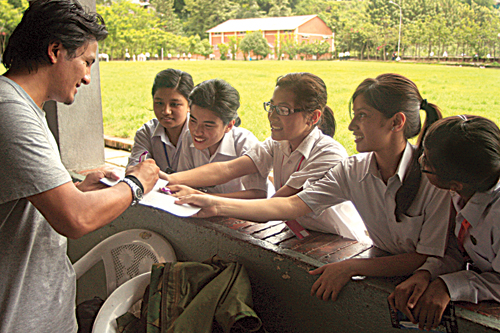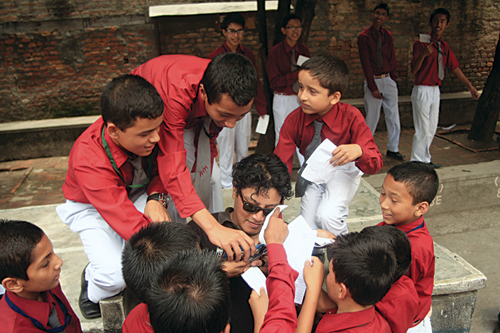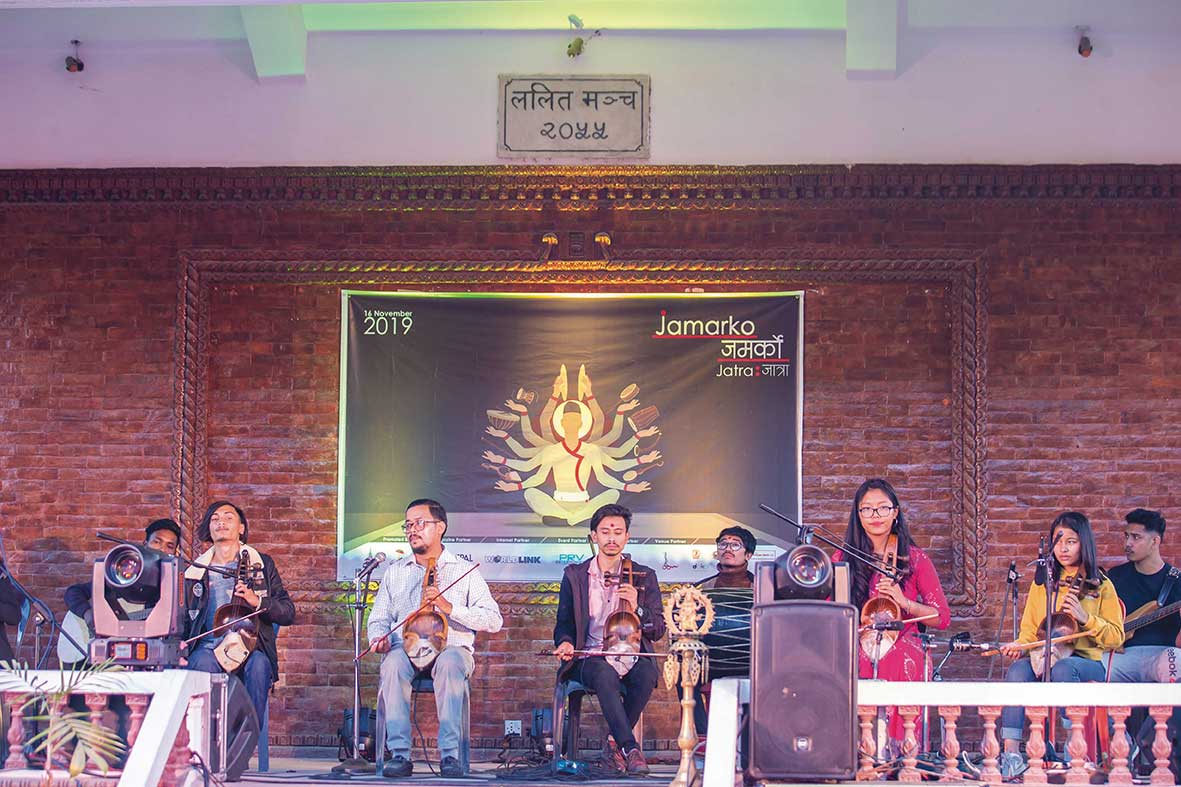“Hami Kutumba! Nepal ma painey lok baja bajaunchau – geet gaudainum.”
A dingy looking hairless dog wagging its skinny tail welcomed me to Kutumba’s somewhat messy practice room. The entrance was quite dramatic. The room was fogged up with cigarette smoke. Hidden behind a wall of smoke stood Siddhartha Maharjan with his younger brother. Siddhartha – who is the youngest member of Kutumba is their effects player – greeted me with a smile and a chilled bottle of Sprite. “You didn’t get lost, did you?” he asked.
 Kutumba’s studio stored huge traditional drums, madals, tungna, arbajo, sarangi, flute and metal percussion instruments that represent the vibrant colors and charismatic characters of Nepal. The walls flaunted the band’s profile with newspaper cuttings, event posters and several ethnic drums hung above a hi-tech battery inverter. Siddhartha cleared a large pile of instruments stacked in front of the door and offered me a seat.
Kutumba’s studio stored huge traditional drums, madals, tungna, arbajo, sarangi, flute and metal percussion instruments that represent the vibrant colors and charismatic characters of Nepal. The walls flaunted the band’s profile with newspaper cuttings, event posters and several ethnic drums hung above a hi-tech battery inverter. Siddhartha cleared a large pile of instruments stacked in front of the door and offered me a seat.
A suitcase with a thick layer of airport stickers chimed as he pushed it further back. “These are my assets,” he said, trying to steady the suitcase filled with metal cymbals, clappers, ghungrus and other percussions. “The instruments have flown across many countries. The bag has served me well keeping the instruments safe,” he added.
 The bags along with the conversation then made its way to Gokarneswor Mahadev, the band’s next concert venue. Band manager Arun Gurung stood in the scorching heat adjusting cables scattered all over the dusty ground. Busy performing his duty, he introduced me to Raju Maharjan, a percussion player who emerged looking tired from the ghaat. “It’s hot today!” he exclaimed and added, “The show will stop if a dead body is brought here,” he said walking towards Arun and Siddhartha, throwing his body in the shade beside the temple wall.
The bags along with the conversation then made its way to Gokarneswor Mahadev, the band’s next concert venue. Band manager Arun Gurung stood in the scorching heat adjusting cables scattered all over the dusty ground. Busy performing his duty, he introduced me to Raju Maharjan, a percussion player who emerged looking tired from the ghaat. “It’s hot today!” he exclaimed and added, “The show will stop if a dead body is brought here,” he said walking towards Arun and Siddhartha, throwing his body in the shade beside the temple wall.
 Gradually the band started getting together and time flew by between random conversation with the crew and other band members. As the light dimmed, Pavit Maharjan, Kutumba’s founding member and percussion player started the show, “Hami Kutumba…” This immediately ignited the crowd, getting them on their feet and the dust that lay stable a moment ago kicked up a storm.
Gradually the band started getting together and time flew by between random conversation with the crew and other band members. As the light dimmed, Pavit Maharjan, Kutumba’s founding member and percussion player started the show, “Hami Kutumba…” This immediately ignited the crowd, getting them on their feet and the dust that lay stable a moment ago kicked up a storm.
The mood of the band and of the audience at every open venue is identical once they start playing their various melodies. The audience settled initially in their comfort zone, movuing close to the main stage later to flaunt their crazy moves. The heavy sound system that the acoustic band carries along however suppressed the chants of the crowd. “Our request to perform in many public places gets denied. We’re a decent looking folk troupe, but the same cannot be said of our fans. We’ve been sent back once for having an audience crazier than those at heavy metal concerts,” said Arun Gurung, post the Gokarneshwor show.
The fame Kutumba has earned has made the band an easy target for many. Leading national media have accused the band of going through the same routine at the same venues time and again. “One read - Kutumba follows the same routine, same venue and same songs,” said Arun Gurung, as he spit off dirt from his mouth after the dusty Gokarneswor show.
With a ready defence strategy for every criticism, the band still flaunts their style to glory but the music and venues they perform at have grown in variety with time. A day after the successful Gokarneswor show, Pavit and I continued our conversation at Laiku, a Near themed restaurant, hidden in an alley in New Road. “Criticism is a direct way of putting forth our weaknesses. They hit us hard and some comments can be heart-rending, yet we make the best of these comments. These flaws that people point out have helped us improve, we dedicate our time in polishing our rough edges and yes, we get a step closer to perfection with every attempt,” said Pavit.
 Ordering a bottle of local aaila at the band’s hangout place, a dimly lit space with, Arun continued after Pavit left. “The band was enraged after reading that article. It was Pavit who with his calm character suggested exploring more venues and collaborating with folk, pop and rock musicians to expand and silence our critics.”
Ordering a bottle of local aaila at the band’s hangout place, a dimly lit space with, Arun continued after Pavit left. “The band was enraged after reading that article. It was Pavit who with his calm character suggested exploring more venues and collaborating with folk, pop and rock musicians to expand and silence our critics.”
Incidents like these have definitely encouraged the band to make sturdier moves aimed toward rising above such pointed remarks. Now, as the band starts to get into a groove with their beats, the audience can take notice of how various instruments from the northern Himalayas to the Terai plains amalgamate to produce a rich Nepali sound that still has a distinct Kutumba style. The dhimey beats borrowed from Kathmandu’s Newars, sarangi, arbajo and flute – favorites of the gaaineys and gothaleys (gypsy-like musicians and cattle herders) and tungna tunes from the lap of the Himalayas mesh together seamlessly, resulting in a sound that is from nowhere in particular but from everywhere at the same time.
Their collaborations with popular rock bands too have worked to their benefit. By playing with popular rock bands such as Albatross and Jindabaad, gypsy jazz guitar player Hari Maharjan and pop singer Astha Tamang Maskey, they not only silenced more of their critics who thought Kumtumba was boring but also displayed their individual musical strengths. It was also a smart move toward introducing their traditional sound to a younger demography who might not have listened to Kutumba before. More recently, Kutumba displayed their creative side by collaborating with up and coming Nepali slam poets Yukta Bajracharya and Ujjwala Maharjan as well as Nepali hip hop band Lyrics Indy for memorable performances that pushed the traditional music band’s envelope toward embracing more contemporary sounds and influences.
 The fame Kutumba has achieved has encouraged many musicians to get into the charms of ethnic instrumental styles. At one point, the hype shook the mainstream music community but quickly faded into oblivion for reasons like misunderstanding amongst band members and others. Still, it cannot be denied that Kutumba has a large role to play in the popularity of Nepali traditional music amongst not just traditional music enthusiasts but also unlikely demographies that were introduced to it via surprisingly effective routes such as slam poetry.
The fame Kutumba has achieved has encouraged many musicians to get into the charms of ethnic instrumental styles. At one point, the hype shook the mainstream music community but quickly faded into oblivion for reasons like misunderstanding amongst band members and others. Still, it cannot be denied that Kutumba has a large role to play in the popularity of Nepali traditional music amongst not just traditional music enthusiasts but also unlikely demographies that were introduced to it via surprisingly effective routes such as slam poetry.
THROUGH THICK AND THIN
With six albums under their belt and the seventh one in the making, Kutumba’s music has reached the far-off corners of the country. The band has stuck together through thick and thin, staying true to their goal of giving new meaning to Nepali folk music. In a band, control over decision-making, financial rights, sense of seniority and egos can affect its members, specially for groups that are successful. Kutumba have has their share of problems too. The band faced some serious ups and downs resulting in the stepping aside of founder-member Rasil Palanchowki and other members. Still, the band has a sturdy reputation of reconciling in more situations – in good times and bad.
 There was a time in the band’s life where they were compelled to sell their maiden album, Kutumba, for a mere 30,000 rupees to a record company. The company is making a fortune from the investment it made about a decade back. Since the incident, Kutumba has grown in leaps and bounds. A huge fan base, plenty of occasions for explorations, a much stronger financial base and a noticeable amount of physical weight too. The decision of selling the copyright of the album, to keep the band intact and pay studio debts paid off well and the band has not turned back since. “We were like fish swimming in a small bowl,” says Pavit adding, “No one was steady financially and we depended heavily on our families. If we hadn’t had sold the album, we would have probably disbanded by now.”
There was a time in the band’s life where they were compelled to sell their maiden album, Kutumba, for a mere 30,000 rupees to a record company. The company is making a fortune from the investment it made about a decade back. Since the incident, Kutumba has grown in leaps and bounds. A huge fan base, plenty of occasions for explorations, a much stronger financial base and a noticeable amount of physical weight too. The decision of selling the copyright of the album, to keep the band intact and pay studio debts paid off well and the band has not turned back since. “We were like fish swimming in a small bowl,” says Pavit adding, “No one was steady financially and we depended heavily on our families. If we hadn’t had sold the album, we would have probably disbanded by now.”
Many of the band members had their minds set on going abroad. Showing a home-video made ten years back, when the band had just formed Arun said, “The nation was not in peace. We were at an age when we could have easily fallen into wrong habits. A group of goons had their junction right in front of Pavit’s sweet shop in New Road and his dad always feared for the worst. His dad had made up his mind of relocating Pavit somewhere safer, most probably in the UK.”
Of his own desires to settle abroad, Arun added, “I wanted to go abroad too. But we’re still here, only two of our former members have settled abroad. We washed away how we felt about this video that we promised to watch together 10 years after its making with all those bottles of aailas we have emptied. We don’t talk about it either.”
 LEARNING ON THE ROAD
LEARNING ON THE ROAD
The band has also been together on the road together, across many borders. While they fondly reminisce of their amazing show in the US at the University of Wisconsin-Madison, they feel that their tour of Janakpur – a musical exchange program – is most remarkable till date. “We are the first commercial band to perform inside the Ram-Janaki temple,” said Kiran Nepali, the sarangi player, with obvious pride. The tour was Kiran’s first time with Kutumba and it was an opportunity for him to experience first hand how the band worked and the sea of support from the people who came to watch them perform. “The band was at their best behavior during the tour. They showed utmost respect to the organizers and the locals. This must have left a positive mark which eventually gave us an opportunity to play our music in a revered heritage site,” said Arun. Speaking of the mega concert that followed the Ram-Janaki gig, Kiran said, “The next day at a show outside the temple, I got to see the massive support from the Janakpur crowd. It was an amazing moment for me. It was the first time I was playing for thousands.”
The Janakpur tour also spoke volumes about the respect Nepalese have for Kutumba’s music. It also shows how music can easily cut across socio-cultural and political borders that otherwise has checked other development and progress across the country.

The hearty welcome and praise that a Kathmandu-based band formed by pahadis (people from the hilly region) received during a time when a Madhes aandolan was simmering overwhelmbed the band members. Tallking about the experience, Pavit said, “Madeshis were fighting for their separate existence and the pahadis living in the Terai had even been assaulted in some instances. The people from the hills living there retaliated violently. We were ready to escape the scene in case anything happened there. We were later relieved when we successfully convinced them that our music didn’t just represent a particular part of Nepal. The whole community stayed peaceful, at least throughout the show. It was a rare achievement. Music spreads love across borders.”
One advantage of playing in Janakpur was that Kutumba also added one more style to their already rich sound. Their subsequent album Mithila, an album comprising the melodies of the Maithali speaking state reflected on their band’s humble learning attitude. “Mithila is a new chapter in Kutumba’s history. We actually explored the Mithila state listening to their music and learning from the experts. We were really impressed by Bhojpuri and Maithali beats and we got to learn the traits of the region’s music,” said Raju.
Comparing Maithali music with Kathmandu’s folklore, Raju added, “I feel that Maithali music and traditional Newari beats are closely related. We didn’t have as many complications as we thought we would have while adapting their beats to our music.” That might be true but the same can also be credited to the fact that Kutumba has successfully integrated various musical influences into their sound in the past without losing what critics and fans alike relate to as the Kutumba sound.
 A MUSICAL MICROCOSM
A MUSICAL MICROCOSM
A fusion representing many geographical regions of Nepal is presented on a common stage when Kutumba gets into their groove onstage. Although their musical base in made up of music you would more likely hear in Kathmandu Valley during festivals and puja ceremonies or on a random morning in Patan’s temples, today’s Kutumba plays a music that is representative of sounds that also echo the high Himalayas as well as the lush Tarai plains. The instruments they hold, strum, beat and shake represents a different kind of unification of the country, one that does away with physical boundaries and speaks a common language that everyone understands.
With time and age, Kutumba has learned how to handle the ups and downs they have faced and their criticism they have received from society. They’ve displayed a smartness by learning from these experiences and using it to their advantage. They’re also slowly realizing the power they have to influence and drive positive change in the country. Some of their tours such as Playing for Heritage which toured villages around Kathmandu Valley in 2011 as well as sites inside the Valley were aimed at spreading awareness about preserving our traditional lifestyle. These might be tangible elements such as architectural sites or intangible ones like festivals and languages. Their partnership with multinational telecommunications company Ncell in 2012 took Kutumba to schools, to a very young demography of Nepalese. It also collected stationery items from elite city schools to distribute to almost 4000 students in village schools.
In many ways Kutumba is acting like more Nepali people from all walks of life should. In realizing their potential and power and acting in a mature way, they’ve grown quickly and are now enjoying the fruits of their hard work and dedication. They’ve been through rough patches but they’ve learned from it and recovered to make up for lost opportunities. While many around them felt their progress would always be checked by their Nepali identity, Kutumba thrived by taking on this challenge. Throughout, they remained more or less the same local boys that enjoy the same things, not letting fame get to their heads. When they perform, a group of friends is who they are and that’s one reason they’ll always be loved anywhere they go where they identify themselves as Nepalis.











